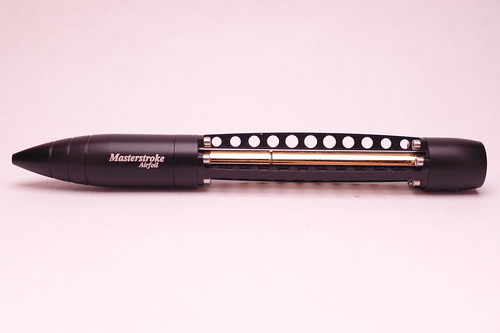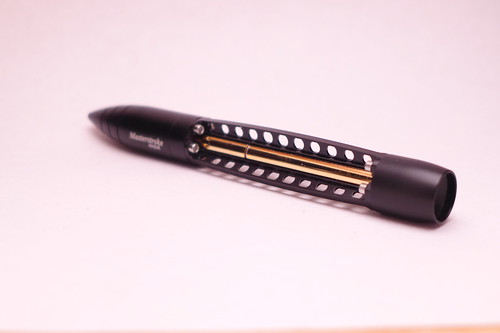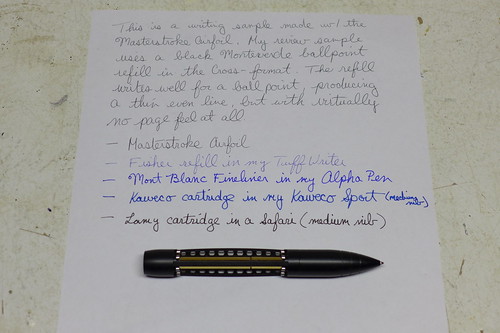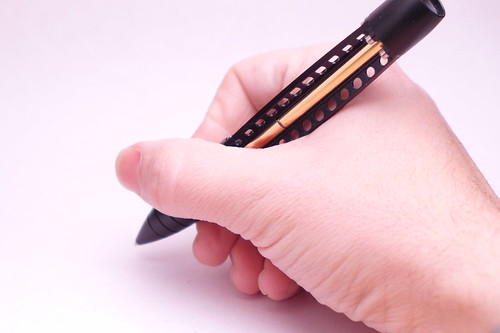Masterstroke Airfoil Review
In 1977 an art museum and library opened in France called the Centre Georges Pompidou. The casual observer probably would have guessed, in 1977, that the building was scheduled to open a few years later as all of the plumbing, support structures, and technical elements were still visible, even on the outside of the building. But the building was not half done when it opened, it was an example of a movement in architecture called "high-tech architecture." The idea is to revel in the technical aspects of a building and that those technical aspects are not only aesthetically pleasing but seeing them creates a sense of solidity and confidence in the building. There is nothing to hide. The massive beams that support modern high rises are there to see. The plumbing and electrical components are readily visible.
Its little surprise that this aesthetic found its way into gear. After all, part of the call of the gear geek is the fact that we revel in technical details and engineering feats. We love the idea of a pivot with bearings or a light with a complex reflector. In pens clear fountain pens, called demonstrators, began their life as tools to show consumers how the guts of the pen worked, and decades later they are among the most popular sellers, even though, in the beginning they were never intended to be sold. Then there are the pieces of kit that are technical marvels both because of their technical achievements and because they show them off. In particular I am thinking of the out of production but still beloved GatLight from Lumencraft.
In a sense the Masterstroke Airfoil borrows extensively from the aesthetic of the demonstrator pen, the GatLight, and the Centre Pompidou. Its guts are not just visible, but exposed, and the result is a pen so striking it could never be mistaken for any other pen. That is an impressive feat given the sheer volume of pens that have been made. That is, in part, why I agreed to take it in for review on a very short time table (so the review could be put out while the Kickstarter campaign was still going)..
Here is the Kickstarter page. I received an aluminum version, but there is a titanium version as well. This is a Kickstarter project so pricing is complicated. You can get an all-black or all-silver pen for $49 if you bid in time, or a colored version for $58. After the Early Birds are gone (which they aren't as of the posting of this review) the prices go up to $59 and $65 respectively. The titanium version are more. The pen is available only through Kickstarter right now. Here is a written review by Ed Jelley. Finally, here is my review sample (sent by the pen's designer and maker Grant Takara):

Twitter Review Summary: Looks like nothing else, smooth as silk with one rough edge (literally).
Design: 2

The Masterstroke Airfoil is a pen that looks like no other and I for one like the very technical look. The pen is divided into three sections--the grip area, the foils, and the tailcap. The pen is a twist design and you extend the writing end by twisting the grip section. The foils are arranged in a cruciform pattern like on old style bayonets (cruicform bayonets have been banned under international law for a very long time, as their shape made wounds that were impossible to sew up and the grooves in the blades made great homes for lots of bacteria). The tailcap does nothing at all, other than to act as a counterweight to the grip section, something that is necessary given the fact that the middle portion of the pen is almost weightless. There will be an option for a pocket clip, though my review sample did not include one. On paper (or in a CAD program) there are few pens as unique looking as the Airfoil.
Fit and Finish: 1
The problem with reviewing prototypes is that it is hard to know what is merely a prototyping flaw and what is a design issue. Here the airfoils themselves are very sharply cut and can be painful when resting on the webbing of skin between your thumb and pointer finger. Grant is aware of this issue and a fix is in the works. See below for more about this.

If that is taken care of, then the pen will be a gem. The rest of this writing tool is simply spectacular. The twist mechanism is amazingly, almost inconceivably smooth, as the nib of the pen extends with almost no effort. The coloring on the body of the pen is uniform and well done. The bolts that hold the airfoils in place gleam as does the gold plated tube that holds the refill. Other than the airfoils, this pen is wonderfully finished.
Carry: 2
The production version will, according to Grant, have the option for a clip. As is the pen carries fine. This is a very large diameter pen but thanks to the airfoil middle section it doesn't weigh a ton. It also carries nicely with other stuff in your pocket as it is quite durable.
Appearance: 2
This is the thing that sets the Airfoil apart. In the above linked review, from the great Ed Jelley, he made it clear that he liked the very unusual looks and I, for one, agree. This is a pen that has a technical feel to it without losing sight of the fact that it is a luxury item. The center brass tube used to house the refill is gleaming and the screws used to hold the airfoils in place absolutely shine. The review sample was black and evenly colored. I liked the black quite a bit, but Ed's red version looked absolutely stunning. The other colors are great looking as well. The unique appearance, coupled with touches of luxury, and bold colors make the Masterstroke Airfoil a beauty attention getter.
Durability: 2
This was a very short review period, so I am not sure how well the pen will hold up over the very long haul, but in the 14 or so days I have had it it has shown no real signs of wear. The pen is mostly anodized aluminum, but there other materials--steel and brass--are also pretty durable. Given the materials and the fit and finish I'd be surprised if the Airstroke was anything less than a good hard use pen.
Writing Performance/Refill: 1
The pen runs a nice ballpoint refill, as the package includes a Monteverde Cross-format refill. For a ballpoint it is quite good. I am not a fan of ballpoints and I am not a fan of the Cross-format refill, but for what it is the Monteverde refill is smooth.
The essential problem is that it, like all ball points, has an oil-based ink that inhibits almost all page feel. This is one of the reasons I'm not gaga over the Fisher refills that dominate the hard use market. There is so little feedback from a ball point and after using fountain pens and the Mont Blanc Fineliner almost exclusively for months, it is noticeable going back. That said, if you like ball points, you'll be happy and the Monteverde is quite good.
The format is a little problematic as well. I think the overall shape of the Airfoil necessitated the long thin Cross-format refill, but that means you will have a lot fewer options. Many, many more options are available in a Parker-format refill, including the stock Fisher refills.
Here is a writing sample made with the Airfoil:

Again, the pen writes nicely for a ball point, but ball points are no better than average in the pen world, even at their best.
Balance/In Hand Feel: 1
The balance here is superior, shocking given the fact that more than half the pen is missing. The tailcap is clearly designed as a counterweight, what with the machined divot and all, and it works well.

Its quite the good pen, balance-wise, given its cigar-sized diameter, yet it is still quite nimble.
That agility however is counteracted by the very sharp airfoils. You can get used to them, but they are very harshly cut, especially for something that is designed to be handled a lot. As I mentioned before, Grant indicated this issue will be addressed in the future. I am not sure if that means it will be addressed between the prototype phase and the production phase or in later models.

The in hand feel, given the foils, is at one and the same time excellent (because of the balance) and below average (because of the sharp foils). You can get used to the foils, just like you can get used to harshly cut jimping, but if they were smoother from the outset the Airfoil would be significantly better in your hand.
Grip: 2
The grip section is quite good, smooth and shaped well. In fact, it is very good. Generally I don't like pens of this girth, because they are pocket anchors, but because of the foils, the Masterstroke Airfoil is very light. The benefits of a cigar-sized pen without the drawbacks--that is a, well, masterstroke.
Barrel: 2
Good looks go along way in making a barrel great, and that is still true here. The real barrel is quite good, as it is a sleek, golden brass tube. Overall, nothing to complain about here, aside from the airfoil's crisp edges but I am not going to ding the pen twice for the same problem.
Deployment/Cap: 2
The twist mechanism here is simply a joy to use. Driving in the car or waiting around in court I often just open and close the pen, reveling in just how amazing this mechanism is. This is easily the nicest twist mechanism I have ever used, including on high end Cross pens and the well-regarded Retro 51s.
Overall Score: 17 out of 20
The Masterstroke Airfoil is a very unique looking pen. For the price of the aluminum model, is quite a decent value for what you get. The foils are a bit jagged and you'll need some time to get used to them. I am not a fan of the refill either, but neither of those issues are fatal blows. The entire pen is a machining feat that echoes the technical look found in other product and building designs. This is a look I like and I like the Airfoil quite a bit.
Follow up
Here is what Grant said about the edges on the airfoils and the potential for a pocket clip:
The production pen will have the option for a clip, I will be releasing the machined prototype photos once they arrive on my doorstep mid next week.
I've gotten the same feedback about the foils from many people and that will definitely be beveled on later models.
Its little surprise that this aesthetic found its way into gear. After all, part of the call of the gear geek is the fact that we revel in technical details and engineering feats. We love the idea of a pivot with bearings or a light with a complex reflector. In pens clear fountain pens, called demonstrators, began their life as tools to show consumers how the guts of the pen worked, and decades later they are among the most popular sellers, even though, in the beginning they were never intended to be sold. Then there are the pieces of kit that are technical marvels both because of their technical achievements and because they show them off. In particular I am thinking of the out of production but still beloved GatLight from Lumencraft.
In a sense the Masterstroke Airfoil borrows extensively from the aesthetic of the demonstrator pen, the GatLight, and the Centre Pompidou. Its guts are not just visible, but exposed, and the result is a pen so striking it could never be mistaken for any other pen. That is an impressive feat given the sheer volume of pens that have been made. That is, in part, why I agreed to take it in for review on a very short time table (so the review could be put out while the Kickstarter campaign was still going)..
Here is the Kickstarter page. I received an aluminum version, but there is a titanium version as well. This is a Kickstarter project so pricing is complicated. You can get an all-black or all-silver pen for $49 if you bid in time, or a colored version for $58. After the Early Birds are gone (which they aren't as of the posting of this review) the prices go up to $59 and $65 respectively. The titanium version are more. The pen is available only through Kickstarter right now. Here is a written review by Ed Jelley. Finally, here is my review sample (sent by the pen's designer and maker Grant Takara):

Twitter Review Summary: Looks like nothing else, smooth as silk with one rough edge (literally).
Design: 2

The Masterstroke Airfoil is a pen that looks like no other and I for one like the very technical look. The pen is divided into three sections--the grip area, the foils, and the tailcap. The pen is a twist design and you extend the writing end by twisting the grip section. The foils are arranged in a cruciform pattern like on old style bayonets (cruicform bayonets have been banned under international law for a very long time, as their shape made wounds that were impossible to sew up and the grooves in the blades made great homes for lots of bacteria). The tailcap does nothing at all, other than to act as a counterweight to the grip section, something that is necessary given the fact that the middle portion of the pen is almost weightless. There will be an option for a pocket clip, though my review sample did not include one. On paper (or in a CAD program) there are few pens as unique looking as the Airfoil.
Fit and Finish: 1
The problem with reviewing prototypes is that it is hard to know what is merely a prototyping flaw and what is a design issue. Here the airfoils themselves are very sharply cut and can be painful when resting on the webbing of skin between your thumb and pointer finger. Grant is aware of this issue and a fix is in the works. See below for more about this.

If that is taken care of, then the pen will be a gem. The rest of this writing tool is simply spectacular. The twist mechanism is amazingly, almost inconceivably smooth, as the nib of the pen extends with almost no effort. The coloring on the body of the pen is uniform and well done. The bolts that hold the airfoils in place gleam as does the gold plated tube that holds the refill. Other than the airfoils, this pen is wonderfully finished.
Carry: 2
The production version will, according to Grant, have the option for a clip. As is the pen carries fine. This is a very large diameter pen but thanks to the airfoil middle section it doesn't weigh a ton. It also carries nicely with other stuff in your pocket as it is quite durable.
Appearance: 2
This is the thing that sets the Airfoil apart. In the above linked review, from the great Ed Jelley, he made it clear that he liked the very unusual looks and I, for one, agree. This is a pen that has a technical feel to it without losing sight of the fact that it is a luxury item. The center brass tube used to house the refill is gleaming and the screws used to hold the airfoils in place absolutely shine. The review sample was black and evenly colored. I liked the black quite a bit, but Ed's red version looked absolutely stunning. The other colors are great looking as well. The unique appearance, coupled with touches of luxury, and bold colors make the Masterstroke Airfoil a beauty attention getter.
Durability: 2
This was a very short review period, so I am not sure how well the pen will hold up over the very long haul, but in the 14 or so days I have had it it has shown no real signs of wear. The pen is mostly anodized aluminum, but there other materials--steel and brass--are also pretty durable. Given the materials and the fit and finish I'd be surprised if the Airstroke was anything less than a good hard use pen.
Writing Performance/Refill: 1
The pen runs a nice ballpoint refill, as the package includes a Monteverde Cross-format refill. For a ballpoint it is quite good. I am not a fan of ballpoints and I am not a fan of the Cross-format refill, but for what it is the Monteverde refill is smooth.
The essential problem is that it, like all ball points, has an oil-based ink that inhibits almost all page feel. This is one of the reasons I'm not gaga over the Fisher refills that dominate the hard use market. There is so little feedback from a ball point and after using fountain pens and the Mont Blanc Fineliner almost exclusively for months, it is noticeable going back. That said, if you like ball points, you'll be happy and the Monteverde is quite good.
The format is a little problematic as well. I think the overall shape of the Airfoil necessitated the long thin Cross-format refill, but that means you will have a lot fewer options. Many, many more options are available in a Parker-format refill, including the stock Fisher refills.
Here is a writing sample made with the Airfoil:

Again, the pen writes nicely for a ball point, but ball points are no better than average in the pen world, even at their best.
Balance/In Hand Feel: 1
The balance here is superior, shocking given the fact that more than half the pen is missing. The tailcap is clearly designed as a counterweight, what with the machined divot and all, and it works well.

Its quite the good pen, balance-wise, given its cigar-sized diameter, yet it is still quite nimble.
That agility however is counteracted by the very sharp airfoils. You can get used to them, but they are very harshly cut, especially for something that is designed to be handled a lot. As I mentioned before, Grant indicated this issue will be addressed in the future. I am not sure if that means it will be addressed between the prototype phase and the production phase or in later models.

The in hand feel, given the foils, is at one and the same time excellent (because of the balance) and below average (because of the sharp foils). You can get used to the foils, just like you can get used to harshly cut jimping, but if they were smoother from the outset the Airfoil would be significantly better in your hand.
Grip: 2
The grip section is quite good, smooth and shaped well. In fact, it is very good. Generally I don't like pens of this girth, because they are pocket anchors, but because of the foils, the Masterstroke Airfoil is very light. The benefits of a cigar-sized pen without the drawbacks--that is a, well, masterstroke.
Barrel: 2
Good looks go along way in making a barrel great, and that is still true here. The real barrel is quite good, as it is a sleek, golden brass tube. Overall, nothing to complain about here, aside from the airfoil's crisp edges but I am not going to ding the pen twice for the same problem.
Deployment/Cap: 2
The twist mechanism here is simply a joy to use. Driving in the car or waiting around in court I often just open and close the pen, reveling in just how amazing this mechanism is. This is easily the nicest twist mechanism I have ever used, including on high end Cross pens and the well-regarded Retro 51s.
Overall Score: 17 out of 20
The Masterstroke Airfoil is a very unique looking pen. For the price of the aluminum model, is quite a decent value for what you get. The foils are a bit jagged and you'll need some time to get used to them. I am not a fan of the refill either, but neither of those issues are fatal blows. The entire pen is a machining feat that echoes the technical look found in other product and building designs. This is a look I like and I like the Airfoil quite a bit.
Follow up
Here is what Grant said about the edges on the airfoils and the potential for a pocket clip:
The production pen will have the option for a clip, I will be releasing the machined prototype photos once they arrive on my doorstep mid next week.
I've gotten the same feedback about the foils from many people and that will definitely be beveled on later models.
